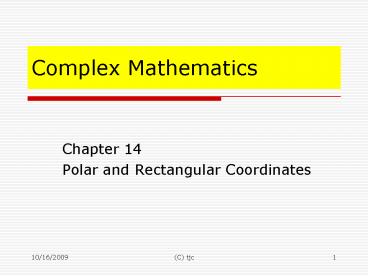Complex Mathematics - PowerPoint PPT Presentation
1 / 26
Title:
Complex Mathematics
Description:
The most common ac measurement device is a multimeter, not an oscilloscope. Therefore ac amplitudes are (nearly) always given as the effective value such as ... – PowerPoint PPT presentation
Number of Views:103
Avg rating:3.0/5.0
Title: Complex Mathematics
1
Complex Mathematics
- Chapter 14
- Polar and Rectangular Coordinates
2
Complex Numbers
- For R, L, C components, what are the two
significant parts of the voltage and current
relationships. - The angular frequency is the same for
combination. - Need to keep track of
- amplitude
- phase angle
3
ac Amplitude
- The most common ac measurement device is a
multimeter, not an oscilloscope. - Therefore ac amplitudes are (nearly) always
given as the effective value such as measured by
a multimeter. - ac amplitudes will be assumed in rms unless
otherwise noted.
4
Amplitude, Phase Angle Graph
Every sinusoid of the same frequency can be
represented by a phasor with length
proportional to amplitude and an angle from the
horizontal equal to the phase angle.
amplitude
q
5
Polar Form
Consistent with text, the phasor C represents a
sinusoid with amplitude C, and phase angle q.
CCÐq
6
Example Phasors
Draw v, i, on a phasor diagram.
2
1
120
30
7
Retangular Form
- A point on an plane can be represented by
Cartesian, x-y, coordinates.
C(A,B)
y
B
A
x
8
Complex Rectangular Form
- We will define the
- x axis as the real axis
- y axis as the imaginary axis
- there is a correspondence to power
- voltage and current on the real axis result in
power consumed as heat - voltage and current on the imaginary axis result
in power stored, not used. - You pay real money for real power that is
consumed.
9
j operator
- In mathematics, the symbol i is used to denote
the imaginary coordinate. - In electronics, j, is used as i is reserved for
current. - An algebraic solution may involve taking the
square root of a negative number. - Cant do that, so define j operator.
10
Define j operator
11
Why j operator?
- Consider
This complex solution is common in electricity.
12
Rectangular Form
- Now the phasor is written
To locate the phasor, move A units along the
horizontal axis then B units along the vertical
axis. Draw a line from the origin (0,0) to the
point. This is the phasor.
13
Rectangular to Polar
- The phasor is the same whether in polar or
rectangular form.
14
Polar to Rectangular
15
Lab Practice
- Laboratory will have conversion practice.
- Bring calculator and learn to use it efficiently.
16
Complex Conjugate
- mirror image about horizontal axis
17
Complex Addition
- Must be in rectangular form.
- exception if angle is 0 or 180.
- Add real and imaginary parts separately.
- Subtraction is addition with a sign change.
18
Graphical Addition
- A B C
- move origin of B to end of A
A
C
B
19
Graphical Subtraction
- A - B A (-B) C
- move origin of -B to end of A
-B
C
-B
A
B
20
Multiplication Rectangular
- Rectangular
21
Multiplication Polar
22
Division Rectangular
- Easy way
- convert to polar.
23
Division Polar
24
Calculator Operations
- learn your own
25
ac Sinusoid
- standard equation
- caution with amplitude gt effective value
26
Phasors
- Draw a phasor diagram for the following
Answer It cant be done. The frequencies must
be the same to use phasor analysis.































